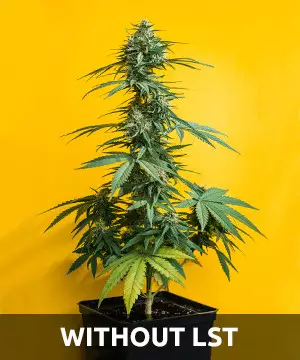
High Stress Training (HST) vs Low Stress Training (LST)
Last updated: 24 July 2025
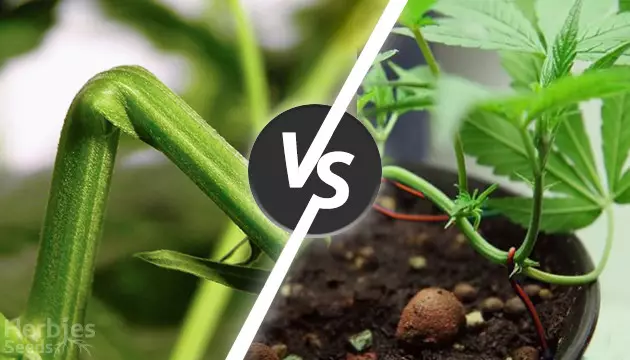
Training cannabis plants is essential for maximizing both yield and quality. Techniques like low stress training (LST) and high stress training (HST) offer significant improvements with only minimal cost and time. LST focuses on gently shaping the plant, while HST involves more aggressive methods to stimulate growth.
The Science Behind Training Cannabis
The growth of a cannabis plant is dictated by auxin, a plant hormone essential for the development of the plant’s body structure. Plants typically have one or a few main buds at the top of the plant, with smaller buds on the branches below. Auxin is highly concentrated at the top of cannabis plants, hence the one main cola that grows on untrained plants. The training techniques in this article can help reduce top heavy growth and instead focus on an even canopy of multiple colas, as well as function to maintain plants at a discreet height by simply bending the plants and encouraging horizontal growth.
Low Stress Training: A Breakdown
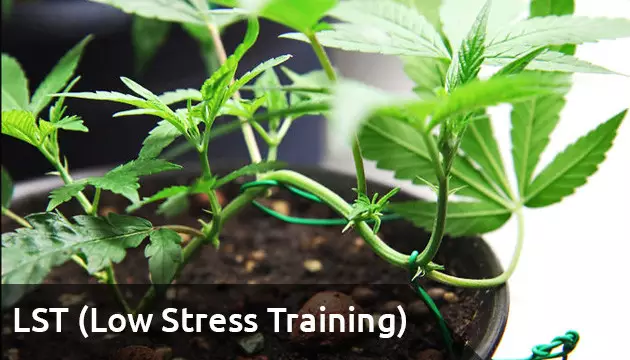
Low stress training (LST) is a hands-on cannabis growing method that gently shapes the plant’s structure for better light exposure and improved yields, comparable to bonsai. The stems and branches are gently manipulated and tied into place, creating a level canopy and dramatically changing the shape of the cannabis plant without causing it any stress. By doing so, multiple bud sites can develop due to their exposure to more light and, thus, the opportunity to develop more auxin. As a result, bud sites on lower branches will develop in size and quantity. LST is also useful for plants that are getting too tall for your setup, or need to be reduced in height to maintain discretion. Low stress training is ideal for small spaces and thrifty growers, also appealing to those who work with auto-flowering strains, as this method places essentially no stress on the cannabis plants.
Advantages of Low Stress Training

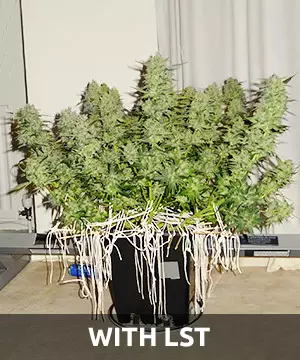
LST allows growers to achieve a much greater yield compared to letting the plant grow naturally in a conical shape. Cannabis plants usually display apical dominance, with one main cola at the top. By training the plant to grow evenly, multiple large colas can form across a flat canopy.
LST has multiple benefits, mostly due to better light distribution. By bending the branches in a way that encourages horizontal growth, the lower branches have the opportunity to absorb more light. The grower can achieve a bigger yield without having to adjust the setup and grow lights; because the colas are all at the same height, the buds will be ready to harvest at the same time. This complete control over the shape, height, and size of the plant requires consistent attention, in that LST is an ongoing process throughout the vegetative state of the cannabis plant, but the grower will be handsomely rewarded with a healthy, hefty crop.
How to LST Your Cannabis Plant
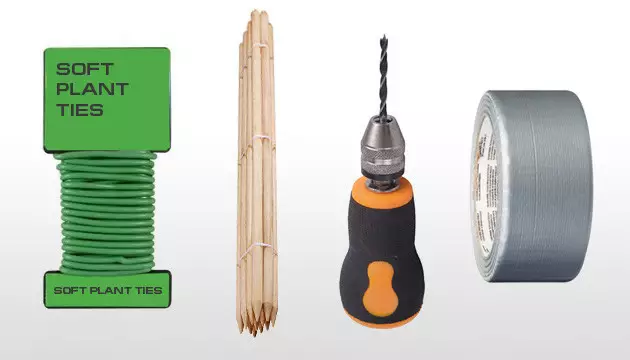
So, you’re ready to start low stress training? This method requires few materials and is a low-cost way to increase the yield of your crop. Here’s what you will need:
- Plant wire or soft plant ties (string or wire not coated in rubber risk damaging the plant)
- Small wooden stakes
- Small hand drill
- Duct tape
Start by drilling small holes around the perimeter of the rim of your growing container. This way you can secure your tied branches to the container. Small wooden or bamboo stakes are ideal for extra support. One should gently pull the branches away from the plant in a star-shaped pattern, helping to expose them to more light and reducing the height of the cannabis plant. Consider the flexibility of the branches; it is optimal to tie them off from the ends of the branches, where they are more pliable and less likely to break. However, accidents happen! If a branch snaps during this process, that’s where the duct tape comes in. Simply bandage up the broken area and the plant is very likely to repair itself within the next several days.
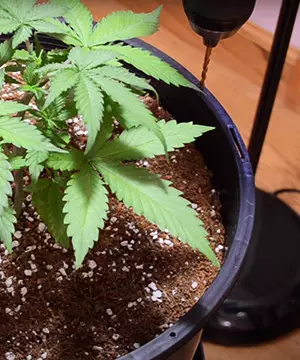
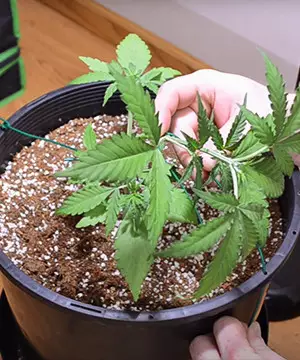
Although many growers top their plants before beginning LST, it isn’t strictly necessary because the main stalk can also be trained to grow horizontally along with the lower branches. Topping is useful for breaking apical dominance, but it is encouraged to skip the topping process with auto-flowering strains, since their vegetative periods are typically not long enough to recover from topping if anything goes wrong.
When is it optimal to start LST?
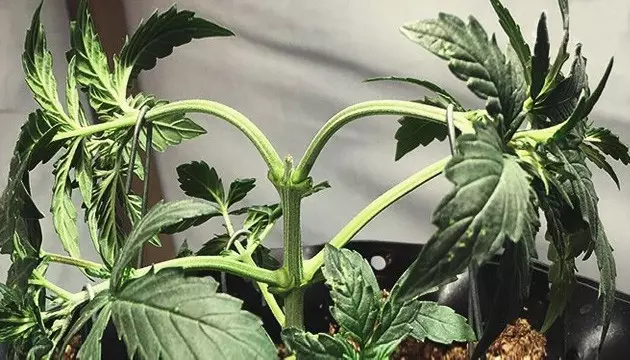
The easy answer: as soon as possible! LST can be started once the cannabis plant has 4-6 good nodes and has established itself in the vegetative state. Anytime during the vegetative state is an appropriate time to start LST, although the earlier the better. Proper LST does not cause the plant any damage and the crop should recover quickly with help from the optimal light exposure. It is not recommended to begin LST in the flowering stage, because by this point the stalks and branches are likely too rigid to respond to training and are at risk for breakage when the plant structure is compromised.
Step-by-Step low stress training tutorial
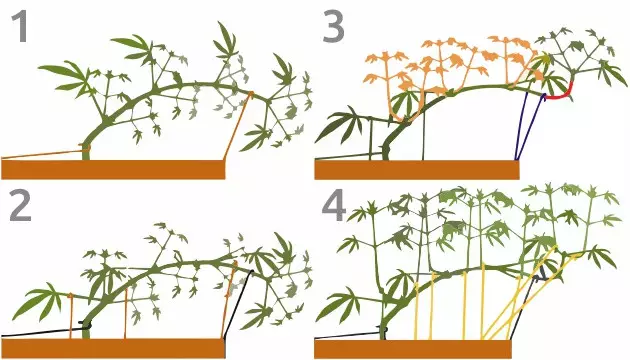
Step 1: Top or bend your plant when it has 4-6 nodes on the main stem
It is common practice to top your cannabis plant (a process explained later) at the beginning of the LST technique, but it is not strictly necessary. Combining LST with a HST method such as topping is a good way to encourage horizontal growth. However, it is possible to LST without topping. Instead, simply bend the main stem down to the same level as the rest of the plant. This step, whether you bend or top the plant, is crucial for breaking apical dominance. If you choose to bend the main stem, secure it in place using soft plant ties and fasten them to the pre-drilled holes around the rim of your container. Be careful to bend the stem at its most flexible point to avoid breakage.
Step 2: Bend the other tallest stems
Next, bend the other tallest stems to create an even canopy and begin encouraging horizontal growth. Once again, be gentle with the branches and work only with those that feel flexible enough to be suitably tied down without breaking. The main idea here is to maintain a level canopy so that all stems are equidistant from the light source. Secure the stems to the container using plant ties. The earlier you train your cannabis plant, the softer and more pliable the stems will be.
Step 3: Maintain a level canopy
Repeat step 2 throughout the vegetative stage once the canopy is uniform and the branches are starting to reach up again. LST is an ongoing process and requires diligent upkeep, and you will see how after a few days the stems start growing upward again. Continue bending and tying shoots horizontally and away from the main stem in a star shape. Pay close attention to your plant to ensure a flat canopy with even light distribution.
Step 4: Watch your cannabis plant flourish in the flowering stage!
Check out all those extra colas growing big and strong! Once your plant enters the flowering stage, all the buds should grow incredibly quickly and at the same pace. At this time, it is also advisable to prune the lowest branches on the cannabis plant, as they will no longer have the chance to get as much light as those on top. Pruning at this stage can boost production at the top of the plant, since the plant will no longer be wasting energy on the lowest branches which have no effect on the ultimate yield of your plant.
Okay, But What About High Stress Training?
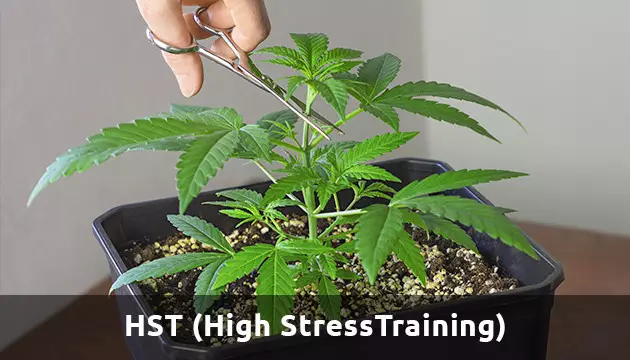
High stress training (otherwise referred to as HST) is a process that involves breaking or removing parts of the cannabis plant in order to optimize the growth of the crop. When done correctly, the yield of your crop can be exponentially increased. This type of training is most common in large outdoor grow operations, and should only be applied to plants that are in the vegetative stage. Once a cannabis plant is flowering, any exposure to extreme stress may be too much to withstand and the plant is less likely to heal itself. The same goes for plants that are weak and sick; HST should be performed only on healthy cannabis plants.
HST: Not just one method to enhance your crop!
By intentionally wounding the plant, the grower can stimulate optimal growth in the cannabis plant. HST techniques involving cutting top growth and bending branches are utilized during the vegetative stage to increase the potency and production of buds during the flowering stage. There are several training methods including topping, FIM, and super cropping, which are detailed below.
Topping
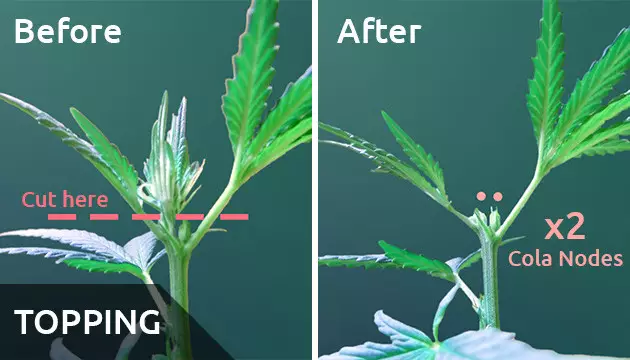
Topping is a very straight-forward, uncomplicated high stress training technique. The only tool you need is your own fingernails! The objective is to clip the top growth of the plant, prompting the cannabis plant to grow two new stems where the top of the plant previously was. This method sends a shock through the entire plant when it is topped, also boosting growth in the lower branches. Topping is an HST approach that may be repeated throughout the plant’s vegetative state, in order to induce a plentiful crop of healthy, hefty buds.
FIM (“Fuck I missed”)
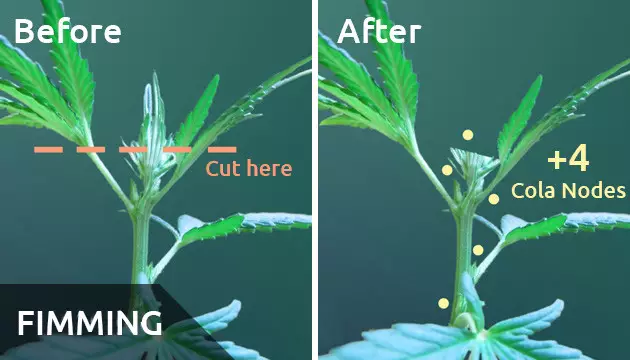
Another HST method, a more complicated version of topping, is FIM, or “Fuck I missed” (humorously implying that topping went wrong). FIM involves the removal of a very specific amount of the top growth of the cannabis plant. When topping, the grower can achieve two off-shooting branches from the clipped portion of the plant; when FIM is executed correctly, the plant will produce four new branches instead of two. An important distinction between the two methods is exactly where the plant is cut. When topping, the entire new growth is removed from the top of the main stem, but with FIM, only the upper half of this new growth is trimmed.
Since this method is more complex and stressful than topping, it does take considerably more time and requires a tool rather than only the fingernails. Recommended would be a pair of pruning scissors or a razor blade, properly disinfected to avoid introducing infection to the cut stalks. The cannabis plant is put at greater risk of illness or infection because the intentional wounding of the stalk is not done with a clean cut at the bottom of the new top growth. When done correctly, this method produces considerably more stems and, later on in the flowering process, plenty of buds.
Super cropping

Super cropping is a high stress training technique that utilizes stem mutilation to decrease the height of the plant and stimulate growth. The goal of super cropping is to break down the inner fibers of the branch so that the stalk becomes pliable and can be trained into another position, all without harming the outside of the stem in the process. Start by grabbing the branch where you would like to bend it, and roll it between your forefinger and thumb. After about ten seconds of rolling and wiggling, you’ll feel the inside of the branch loosen up and become more flexible. Once it is soft enough to bend without breaking, secure the branch to stay bent, ideally with plant twist ties (but regular zip ties should also be okay). If the outside of the stalk does happen to snap or tear in the process, bandage up the exposed area with some duct tape and remove after a week or so. Chances are, your cannabis plant will heal herself right up!
Although super cropping is an HST method, it mirrors the techniques behind LST in a more aggressive manner. As opposed to tying down the the branches of the plant, the grower bends the branches until the inner fibers break down and become flexible enough to fold over. This technique is best done while the cannabis plant is still in its vegetative state, or only very early in the flowering stage, because it is not recommended to stress your cannabis plants during flowering. Super cropping is a great method to give the lower branches of your cannabis plant the opportunity for more light exposure and to develop at a similar rate to the top stalk.
How HST can increase your success

The benefits of high stress training are similar to those of low stress training, in that when done correctly, HST can result in shorter plants with many more buds than an untrained plant. It is also understood that high stress training can increase the levels of THC and CBD in cannabis plants, because cannabinoids act as the cannabis plant’s defense system in the wild. Topping and cutting the plant puts it under stress, and it follows that the crop would increase its protection when under attack.
The purpose of these cannabis training techniques is to modify the physical and chemical balances in the plants by reducing the naturally upward focused growth of cannabis plants and instead encouraging the plant to grow a level canopy. Especially in an indoor garden, the light source should only be as close as is ideal for the top cola. When all colas are at a similar level, the lower branches have the opportunity to absorb more light and grow larger at the same time as the main top cola. When done correctly, LST and HST methods can drastically increase the yield and potency of the crop. Plant bending techniques are very useful for growers with limited grow space, value discretion and thus need to maintain a specific height for their plants, or simply those who wish to maximize the potential of their grow.
Herbies Head Shop expressly refuses to support the use, production, or supply of illegal substances. For more details read our Legal Disclaimer.

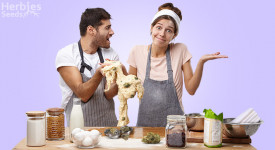


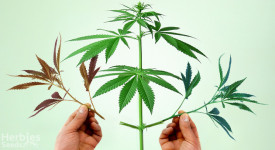

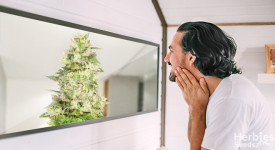



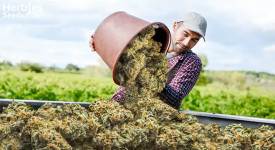


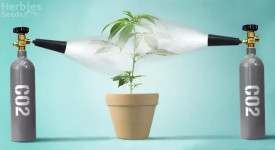




Thank you for leaving a comment for us!
Your feedback will be posted shortly after our moderator checks it.
Please note that we don’t publish reviews that: